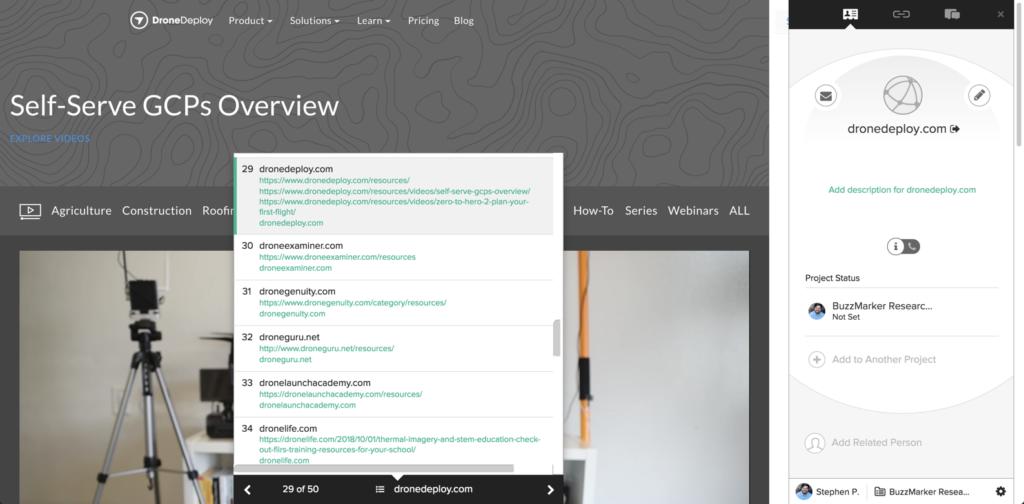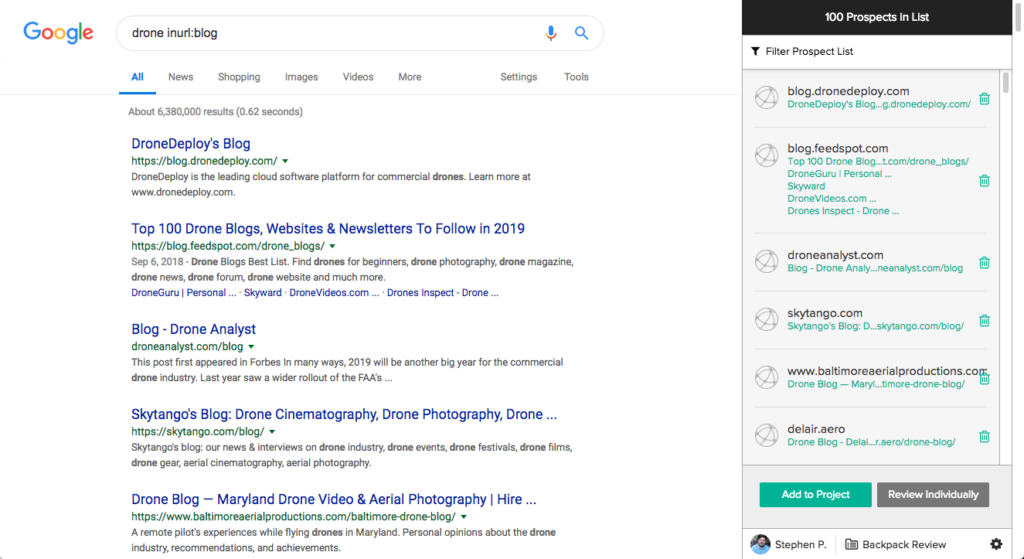Table of Contents
Whether you’re putting together your list for the first time, reviewing data that we’ve discovered for a list that you’ve imported, or gathering relevant context to send effective outreach to contacts, you’ve got to find the right information at the right time.
To help you out with that, we’ve added some major functionality that will make your research faster, more direct, and more obvious. We’ve got a lot to cover, so let’s jump right in.
Research Links
First, let me introduce you to your new best friend for gathering context or on page information for contacts that you’ve added to BuzzStream: the Research Link.

Research Links capture the specific URLs that you leveraged when adding a contact so you can quickly use them to gather information, build context, or refer to them when sending an email. For example, if you were running a campaign targeting resource pages and added one based on a Google SERP result using the BuzzMarker, we would turn the specific page found in that SERP into a Research Link that you can return to at any time.

The Research Link is a new history item and can be found by simply clicking on a contact and reviewing the history. If there are a lot of other history items such as notes and emails you can also filter on Research Links to quickly surface all of the ones associated with that contact.

Review with BuzzMarker
With all of those fancy new research links added, we also wanted to give you a new way to quickly review and act on them. Now you can research contacts in your database using the BuzzMarker with our new Review button.

The Review button gives you a great way to vet a list of contacts, gather information from research links, or give context to your team when reaching out.
To use the Review button, just highlight the contact you’d like to review and it will become available to you.

From there you’ll be taken into the BuzzMarker where you can review all of the links associated with your contact, including their top level domain and all of the Research Links attached to that contact.

Bulk Add From BuzzMarker
While we were tinkering with the BuzzMarker, we also figured that we could give our users a faster way to get contacts into BuzzStream to begin gathering metrics and contact information in situations where you didn’t want to vet all of their contacts up front. For instance, if you wanted to add results from a number of SERP keywords then vet and filter them based on metrics such as DA or discovered contact information. So, we’ve given you the ability to bulk add contacts into your BuzzStream projects using the BuzzMarker.
To do that, just start a prospecting list using the BuzzMarker and the option to add all of the prospects to a project will be made available to you. Select that option and you’re good to go. Of course, if you’d still rather view the contacts up front before adding them to your project to ensure quality that option remains available to you.

Smart Behavior for URL Lists in BuzzMarker
So…we just couldn’t stop tinkering. As we were adding the ability to bulk add contacts from the BuzzMarker we realized that the existing process of right clicking on a page with a list of URLs then selecting BuzzStream BuzzMarker and then selecting Start Prospecting was a pain in the ass.

Now, when you click the BuzzMarker icon on a page with a list of URLs we’ll intelligently detect it and start a Prospecting List for you.

Removal of BuzzBar in the Contact Grid View
As we expand and improve the product, some features do sadly need to be left behind. In order to accommodate the new Review capabilities, we are going to stop supporting the ability to view existing contacts in the BuzzBar. Although we know that many users have gotten tremendous value out of the BuzzBar, unfortunately there are major impediments to continued development. Most prominently among these are the requirement to load unsafe scripts in order to view pages in the BuzzBar, as well as difficulty loading some page elements in the BuzzBar frame.
Moving forward, new customers will not see the BuzzBar in their accounts in the contact grid view. However, we will still be keeping the BuzzBar as the primary way to review Prospecting Searches for the time being.
Change in Behavior for Adding From Twitter
One final announcement related to the BuzzMarker that we wanted to make you aware of. Previously, when adding contacts from Twitter using the BuzzMarker we would give you the choice to add them as People or Websites. Moving forward, those contacts will be added as Websites by default.
Although this does remove some of the flexibility of determining Twitter contact type, it has made it difficult to build out our social prospecting capabilities (hint: stay closely tuned here) and has also led to unnecessary confusion for many customers.
Of course, you can still add an associated person to a Twitter record if you want to put together a list of people to reach out to.
Wrapping Up
We sincerely hope that you enjoy the new BuzzStream Research features that we’ve put together. As always, we’d love to hear your feedback, and are more than happy to answer any questions you’ve got as well!
If you haven’t downloaded the BuzzMarker yet, you can do that right here. And if you haven’t started a BuzzStream trial to send better, more intelligent outreach, what are you waiting for? Start a free trial today.

 End-to-end outreach workflow
End-to-end outreach workflow



 Check out the BuzzStream Podcast
Check out the BuzzStream Podcast


3 comments
Smart and intuitive updates! Great news indeed!
Hey – I freaking LOVE this.
Much awaited!!!!!!
Awesome work. This makes prospecting MUCH easier for SURE!!!
A few questions:
1. Will this deduplicate links. In your example you did backpack intitle:review and added all sites in to 100.
Ok what if we did backpack inurl:review next and added those sites.
Will Buzzstream dedupe?
2. I have not logged into buzzstream yet. So i have not checked. Can you pull in the article URL or TITLE from research links into emails?
Awesome! Great to hear it’s going to be helpful for you.
To answer your questions:
1. Yes, research links will deduplicate by project so if you run a number of searches with the same domains in each one we will only add new links on subsequent searches.
2. Currently we don’t have a dynamic field for research links but it’s on our agenda/to-do list along with a few other followup improvements.